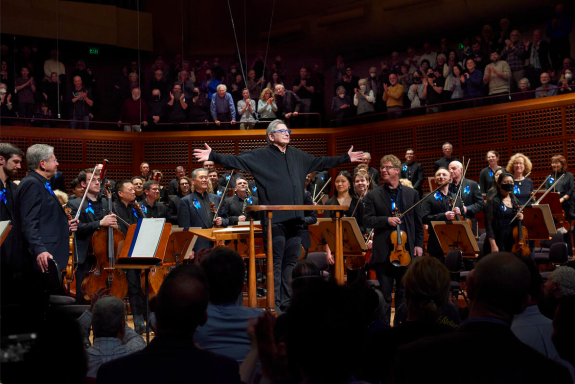 United States Mahler: San Francisco Symphony / Michael Tilson Thomas (conductor). Davies Symphony Hall, San Francisco, 25.1.2024. (HS)
United States Mahler: San Francisco Symphony / Michael Tilson Thomas (conductor). Davies Symphony Hall, San Francisco, 25.1.2024. (HS)

Mahler – Symphony No.5 in C-sharp minor
Michael Tilson Thomas stepped carefully, making his way slowly between the first violins and the cellos. Short of the podium, he turned to greet concertmaster Alexander Barantschik. In lieu of a bow, he used his baton to make a gesture reminiscent of a salaam toward the audience and, with a smile, tapped a crossed blue ribbon pinned to the violinist’s lapel. All the musicians wore identical ribbons in the bright blue hue of the conductor’s signature eyeglasses.
The capacity throng at Davies Symphony had risen for a standing ovation even before the first note. A brain tumor has slowed MTT physically since it was diagnosed in 2021 and removed. It was not lost on the audience that he had recently withdrawn from two subscription performances, and no future concerts have been announced. Barring some special event, this weekend’s concerts would be his last series with the orchestra he led as music director for 25 years.
Mounting the podium, he stopped for a few seconds to soak up the love, and then turned to face the orchestra. A hush fell as he raised the baton to summon the first quiet measures of the funeral march that opens Mahler’s Symphony No.5.
The big gestures and lavish body-language of his conducting style are gone now, but he stood erect – no perching on a stool for him – as he coaxed out the music with minimal arm and hand movements. What emerged was magical, an account of this sprawling 80-minute score that can only be described as refined. My dictionary offers three definitions of that adjective: ‘with impurities or unwanted elements having been removed by processing’, ‘elegant and cultured in appearance, manner or taste’, and ‘developed or improved so as to be precise or subtle’. All three applied.
There was no wasted effort in Tilson Thomas’s conducting and nothing excessive in this performance, yet it had all the energy one could want. The music built up repeatedly, only to retreat to gather its breath rather than crumbling awkwardly (as some do, and this conductor has done in past performances). Transitions shifted smoothly, no easy task when Mahler’s music so often turns on a dime into a different dimension. And yes, there was precision in delicate moments and in run-ups to crashing climaxes. The final measures gave in to pure joy.
As for subtlety, that is what characterized the famous Adagietto, which found an ideal tempo to convey the music’s languor and kept an underlying pulse to stir the emotions. Katherine Siochi, the orchestra’s new principal harpist, contributed elegant accents as the string sound seemed to float weightlessly.
Associate principal trumpet Aaron Schuman delivered the first movement’s minor-key trumpet fanfares with precision, matching the unfolding moments with tone colors as the context changed against shifting harmonies. At one point, his lyrical legato phrases reminded me of Miles Davis, which might seem odd for Mahler but fit perfectly. The French horn solos were executed with remarkable presence by visiting guest artist Michael Stevens of the Rochester Philharmonic (as principal Robert Ward retired in December). The entire horn section distinguished itself in a symphony where there is a lot for them to play.
The fiercely rhythmic Scherzo, the center of the piece, drove with power but never overstepped into roughness. The music danced with a rustic bounce.
After the respite of the Adagietto, the finale reveled in joyous exclamations from the brass, as if to answer the gloom of the funeral march at the start with bright lights and glorious major chords at the finish. If Tilson Thomas meant to convey that he wanted no solemnity, only joy, he delivered.
A brief silence let the magnificence of what had just happened sink in, and then the audience rose as one for a long and clearly heartfelt ovation. Still facing the orchestra, Tilson Thomas laid down his baton and applauded them, as if offering a benediction to each section. He signaled the orchestra to stand for a group bow, turned toward Barantschik and, still applauding, cautiously stepped off the podium.

Rather than walking off the stage and back for a curtain-call, he simply stepped back onto the platform and pointed to hornist Ring for the first solo bow. Ring held up his French horn and the audience roared. Next up was Schuman, playing principal trumpet in the absence of Mark Inouye (on leave). Rainer Eudeikis, in his first season as principal cello, got a bow, and timpanist Edward Stephan, who was kept busy throughout the score. So did harpist Siochi.
With a deep breath, the conductor finally turned to the audience, spreading his arms wide as if to embrace the 3,000 in attendance. The ovation continued until he slowly climbed the risers to exit.
Harvey Steiman
